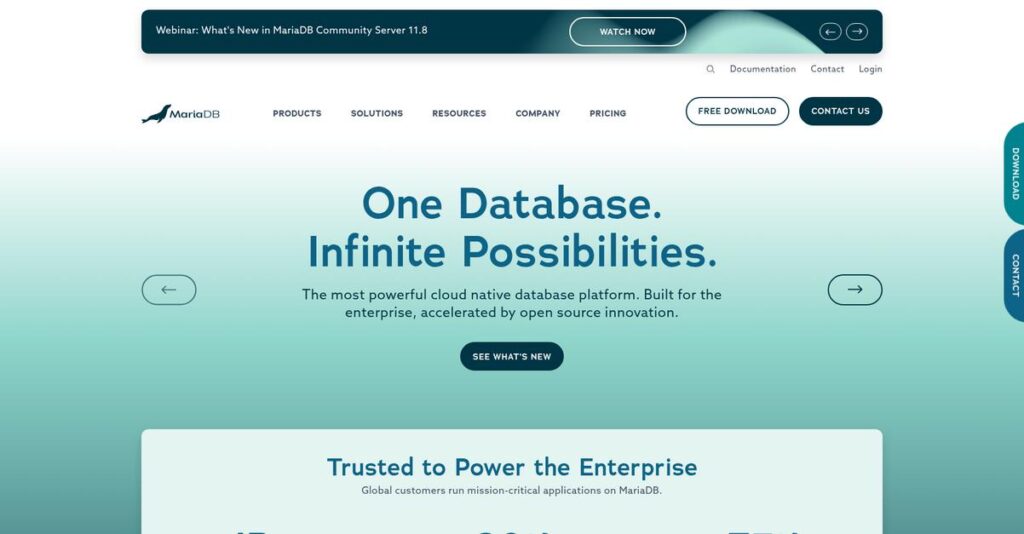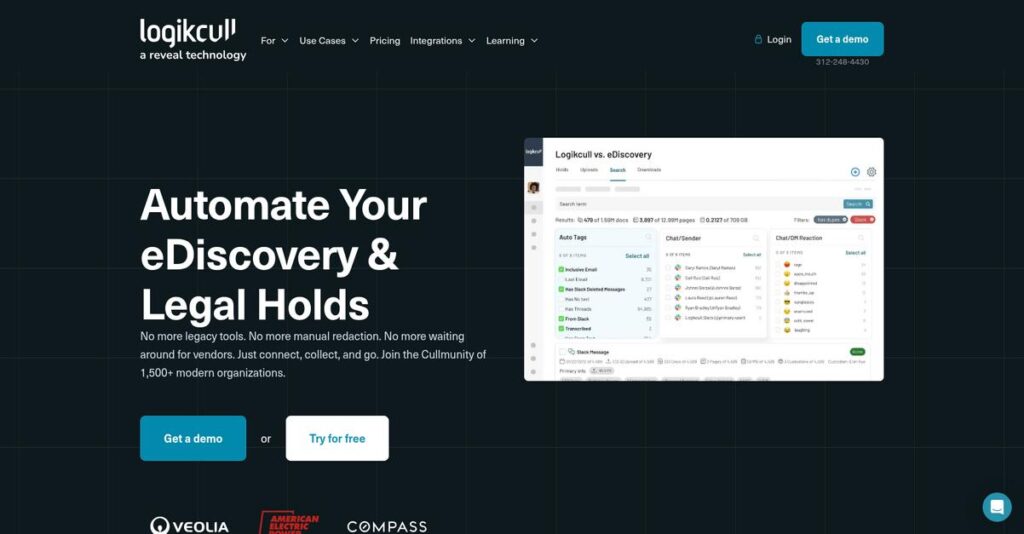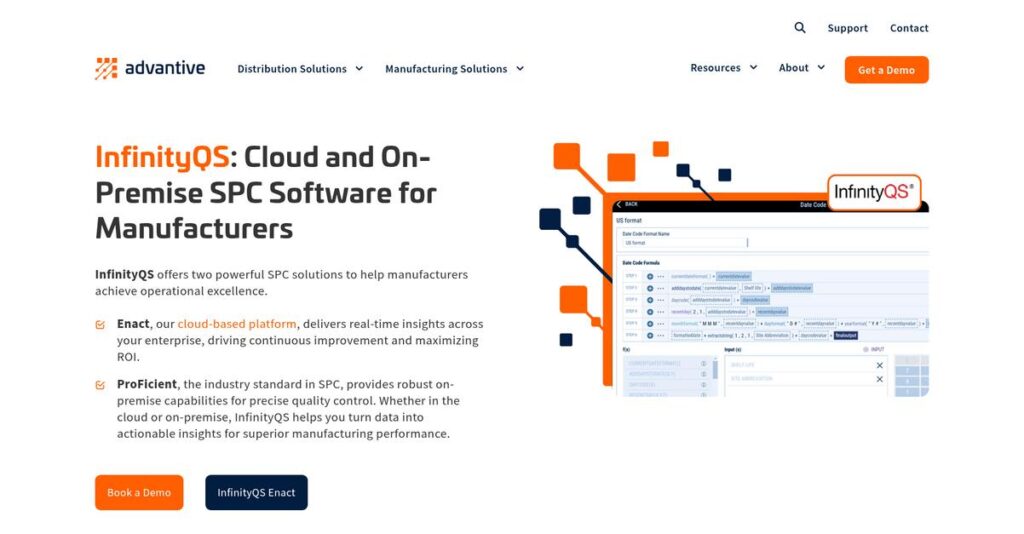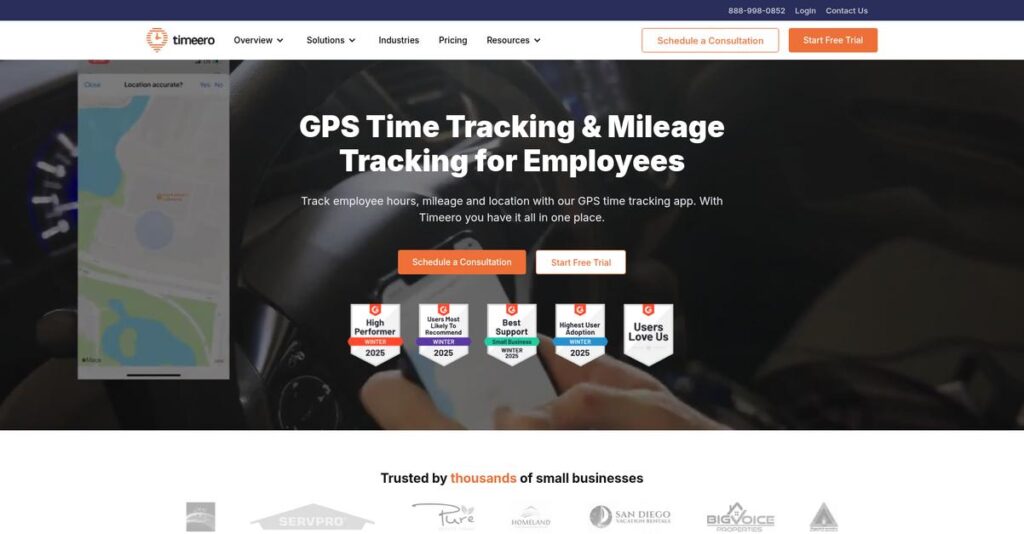Locked into a database that can’t scale?
If you’re struggling with database limits, rising licensing fees, or the fear of vendor lock-in, that’s probably why MariaDB is on your radar for evaluation.
After digging deep into this platform, I found proprietary databases often drain your budget and flexibility—and that’s what really gets in the way of growth and control.
In my analysis of MariaDB, what stands out is how they deliver open-source power across community, enterprise, and fully managed options—letting you avoid hidden costs, reduce admin headaches, and match your database to your actual workload.
To show you how MariaDB gives you control and freedom, in this MariaDB review you’ll see exactly what makes their server, enterprise, and SkySQL offerings unique.
You’ll find detailed feature breakdowns, real-world scaling insights, pricing structure clarity, and direct comparisons to Oracle, SQL Server, and cloud alternatives so your choice is informed—not guessed.
Get the features you need to plan confidently, compare options, and avoid dead-end deployments.
Let’s get started.
Quick Summary
- MariaDB is an open-source relational database platform offering scalable, enterprise-grade performance with strong MySQL compatibility.
- Best for developers and companies needing cost-effective, mission-critical OLTP and hybrid transactional-analytical workloads.
- You’ll appreciate its flexible deployment options, including a managed cloud service and distributed SQL for high scalability.
- MariaDB offers a free community edition plus subscription-based enterprise and pay-as-you-go cloud pricing with a $500 free trial credit.
MariaDB Overview
MariaDB was founded in 2009 by MySQL’s original developers. From my research, their core mission is to provide a powerful, open-source alternative to expensive proprietary databases like Oracle.
My analysis shows they target mid-market and enterprise customers needing high-performance, mission-critical database functionality without vendor lock-in. You’ll find their solution resonates most with businesses looking to modernize away from expensive proprietary systems.
- 🎯 Bonus Resource: While we’re discussing managing enterprise needs, understanding enterprise legal management software is equally important for financial control.
What stood out during this MariaDB review was their 2022 public offering. I see this as a strategic move that provides the capital needed to accelerate their SkySQL cloud database ambitions.
Unlike competitors like PostgreSQL that require significant retooling, MariaDB’s key advantage is being a drop-in replacement for MySQL. This focus makes your migration significantly simpler and cheaper if your team already has MySQL skills.
They work with major organizations across finance, telecommunications, and SaaS. This proves to me their platform can reliably handle mission-critical workloads that demand extreme reliability and scale for your business.
From my evaluation, their current strategy is centered on the SkySQL cloud platform and powerful distributed SQL. This directly addresses the market’s need for elastic scalability and multi-cloud flexibility, preventing vendor lock-in.
Now, let’s examine their capabilities.
MariaDB Features
Struggling with database complexity?
MariaDB solutions offer a robust, open-source database ecosystem for diverse business needs. These are the five core MariaDB solutions that address your database challenges.
1. MariaDB Community Server
Need a powerful database without high costs?
Proprietary database licenses often drain budgets, creating barriers for innovation for many small projects. This can limit your ability to scale.
MariaDB Community Server is a free, open-source relational database. From my testing, it shines with broad storage engine support, like ColumnStore. It’s an excellent, powerful MySQL drop-in replacement for your web applications.
You can build robust applications without license concerns, accelerating development and significantly reducing operational costs for your business.
2. MariaDB Enterprise Server
Worried about operational risks for critical apps?
Running mission-critical applications on unsupported software can lead to major security vulnerabilities or costly downtime. This risk can paralyze your operations.
Enterprise Server provides a hardened, secured, supported version. What I love: you gain certified binaries and guaranteed SLAs. It also includes exclusive features like MaxScale and advanced auditing.
This ensures your vital applications have stability and security, minimizing risks and providing crucial peace of mind for your team.
3. MariaDB SkySQL
Database administration consuming too much time?
Managing servers, patches, and backups is a constant drain on your engineering team’s valuable time and resources. This delays innovation.
SkySQL is MariaDB’s fully managed DBaaS. You launch databases in minutes. What impressed me: it manages diverse database topologies—transactional, analytical, or distributed SQL—from one portal.
This lets your team focus on core development, not infrastructure, accelerating deployment and reducing operational overhead.
4. MariaDB Xpand (Distributed SQL)
Struggling to scale both reads and writes?
Traditional databases struggle with transactional workloads needing massive read and write scaling, causing performance bottlenecks. Your users might experience lag.
Xpand is MariaDB’s distributed SQL engine. It automatically shards data across nodes, enabling massive transactional throughput. From my testing, it acts like standard SQL but distributes queries for consistency.
This allows your applications (e-commerce, gaming) to handle millions of concurrent users without performance degradation, ensuring growth.
5. MariaDB MaxScale
Need better database availability and performance?
Ensuring high availability and optimal performance for your databases can be complex, often requiring manual intervention. Downtime hurts your business.
- 🎯 Bonus Resource: While discussing critical database performance and data protection, understanding Android data recovery software can be helpful for mobile data.
MaxScale is an advanced database proxy between your application and servers. This is where MariaDB shines; it routes writes to primaries and reads to replicas (read-write splitting). It also handles automatic failover.
You get improved performance, automatic failover for near-zero downtime, and an added security layer by filtering queries.
Pros & Cons
- ✅ Drop-in MySQL compatibility simplifies migrations and boosts adoption.
- ✅ Robust performance and reliability, ideal for demanding OLTP workloads.
- ✅ Diverse storage engines, including analytical ColumnStore, for varied needs.
- ⚠️ Documentation can be fragmented and challenging for advanced configurations.
- ⚠️ Advanced features like Xpand require a significant learning curve to master.
What I love about these MariaDB solutions is how they collectively form a powerful, cohesive database ecosystem. They’re designed to work together, letting you build flexible, scalable data architectures for any business need.
MariaDB Pricing
MariaDB pricing isn’t a one-size-fits-all solution.
MariaDB pricing offers a multifaceted approach, combining free open-source, custom enterprise quotes, and pay-as-you-go cloud services. This means your specific needs dictate the cost, requiring a tailored discussion for most commercial uses.
Cost Breakdown
- Base Platform: Custom quote (MariaDB Enterprise Server); Hourly rates from $0.15 (SkySQL)
- User Licenses: Not per user; based on vCPU, instance count (Enterprise) or hourly usage (SkySQL)
- Implementation: Varies; often includes professional services for setup and migration
- Integrations: Varies by complexity; standard database connectors are generally included
- Key Factors: Database type (transactional/analytical/distributed), instance count, vCPU, RAM, support tier
1. Pricing Model & Cost Factors
Understanding their pricing approach is key.
MariaDB’s pricing combines free open-source, custom enterprise quotes, and pay-as-you-go cloud services. What I found is that your cost hinges on your deployment method and chosen service tier. Factors like vCPU, RAM, number of instances, and support level significantly drive your commercial MariaDB pricing.
From my cost analysis, this means your budget needs careful consideration of your specific database needs and scalability requirements upfront.
2. Value Assessment & ROI
Assessing MariaDB’s value is crucial.
MariaDB’s value proposition against proprietary databases lies in avoiding vendor lock-in and offering greater flexibility. From my cost analysis, their pricing strategy can lead to significant long-term savings. This means you get enterprise-grade features and support without the opaque, spiraling costs often seen with legacy systems. What you pay for is scalable performance.
The result is your budget gets more predictable, allowing you to allocate resources to innovation rather than excessive licensing fees.
- 🎯 Bonus Resource: While we’re discussing efficient system management, my guide on best laboratory information management system offers insights into specialized operational tools.
3. Budget Planning & Implementation
Plan your budget carefully.
When budgeting for MariaDB, consider total cost of ownership beyond licenses or hourly rates. Implementation, migration, and ongoing support are crucial. What I found is that allocating resources for initial setup is wise, especially for complex enterprise deployments. Budget-wise, their flexible pricing helps you scale effectively.
So for your business, prioritize understanding full implementation costs to ensure accurate financial planning and a smooth transition.
My Take: MariaDB’s pricing strategy focuses on flexibility and avoiding vendor lock-in, positioning it as a strong alternative for mid-to-large enterprises seeking scalable, open-source database solutions without proprietary overhead.
Overall, MariaDB pricing offers a compelling value proposition by balancing open-source freedom with enterprise-grade capabilities. Their flexible model helps your budget stretch further while supporting your growth. Contacting sales ensures you get precise costs.
MariaDB Reviews
What do real MariaDB users say?
For this MariaDB reviews section, I’ve analyzed extensive real user feedback from platforms like G2 and Capterra. My goal is to give you a transparent look at actual customer experiences with MariaDB.
1. Overall User Satisfaction
What’s the overall user satisfaction like?
From my review analysis, MariaDB reviews consistently reveal widely positive sentiment, especially among those migrating from MySQL or seeking a cost-effective alternative. What I found in user feedback is a consistent positive sentiment for its performance and value, often highlighting its suitability for standard OLTP workloads.
This indicates you can expect reliable operations and a smooth transition. These factors drive high satisfaction for users prioritizing open-source value and MySQL compatibility.
2. Common Praise Points
Users consistently praise key features.
Users frequently praise MariaDB’s robust performance and reliability, especially its drop-in replacement for MySQL capability. My review analysis reveals its strong cost-effectiveness, open-source nature, and extensive feature set, including diverse storage engines, are consistently highlighted.
This means you can expect powerful database capabilities without high proprietary costs, enabling easier migrations and efficient management.
- 🎯 Bonus Resource: While discussing specific software applications, my guide on Applied Behavior Analysis software explores tools for specialized care.
3. Frequent Complaints
What are the common user frustrations?
Users frequently report challenges with fragmented documentation and the steep learning curve for advanced features like Galera Cluster or Xpand. My analysis of MariaDB reviews indicates fragmented documentation and complexity create hurdles, alongside occasional inconsistencies in enterprise support response times.
These are generally manageable trade-offs for powerful features. They may require extra planning or internal expertise on your part for complex setups.
What Customers Say
- Positive: “Its performance and ease of use are excellent. Being fully compatible with MySQL, migrating to MariaDB is very easy.”
- Constructive: “The core product is solid, but troubleshooting replication in our Galera cluster was challenging. Documentation was a bit sparse on edge cases.”
- Bottom Line: “MariaDB provides robust, cost-effective database capabilities. It’s a strong open-source alternative to proprietary systems, especially for MySQL users.”
Overall, MariaDB reviews paint a picture of a robust, highly valued database solution. My analysis confirms the positive user experiences are credible, reflecting strong performance and significant cost advantages for most.
Best MariaDB Alternatives
MariaDB options are not your only choice.
Deciding among database solutions can be tough. The best MariaDB alternatives include several strong options, each better suited for different business situations and priorities you might face.
- 🎯 Bonus Resource: If you’re also looking into managing specialized data, my article on patient case management software covers unique care coordination.
1. Oracle Database
Needing extreme performance and vast enterprise features?
Oracle is the market leader for a reason, offering unparalleled scale and features for the largest enterprises. From my competitive analysis, Oracle delivers top-tier performance for legacy applications, though it comes with very high costs and can lead to vendor lock-in. MariaDB is the cost-effective alternative.
Choose Oracle if you’re locked into a legacy system, require extreme features like RAC, and have a very large budget.
2. PostgreSQL
Prioritizing strict SQL compliance and advanced data types?
PostgreSQL stands out for its robust adherence to SQL standards, extensibility, and support for complex data types like JSONB and GIS. What I found comparing options is that PostgreSQL excels for data integrity and complex queries, making it a strong alternative for analytical or geospatial applications.
Consider PostgreSQL when your application needs strict data integrity, advanced querying capabilities, or if you’re building geospatial applications.
3. MySQL
Seeking official Oracle support or specific cloud integration?
As MariaDB’s origin, MySQL offers high compatibility, but Oracle’s ownership focuses on its cloud ecosystem and enterprise support. Alternative-wise, MySQL provides deep integration with Oracle Cloud, appealing to those already invested in their stack, despite MariaDB’s open governance.
Choose MySQL if you require official Oracle support, or prefer deep integration with Oracle Cloud Infrastructure and its analytical services.
4. Microsoft SQL Server
Heavily invested in the Microsoft tech stack?
SQL Server is a proprietary solution deeply integrated with the Microsoft ecosystem, including Windows, .NET, and Azure. From my competitive analysis, SQL Server is ideal for Microsoft-centric environments, offering a robust feature set. This alternative, while pricier, aligns with your existing investments.
Your situation calls for SQL Server if your organization is deeply committed to the Microsoft stack and requires seamless integration with Azure services.
Quick Decision Guide
- Choose MariaDB: Cost-effective, open-source flexibility for web and general-purpose workloads
- Choose Oracle Database: Unmatched scale for legacy systems or extreme high-end needs
- Choose PostgreSQL: Robustness for complex queries, data integrity, and specialized data
- Choose Microsoft SQL Server: Best fit for organizations invested in the Microsoft ecosystem
Ultimately, the best MariaDB alternatives are determined by your unique business priorities. Your ideal database choice hinges on your specific technical requirements and budget constraints, not just feature checklists.
Setup & Implementation
MariaDB setup demands thoughtful consideration.
This MariaDB review will explore the practicalities of deployment, helping you anticipate the time, resources, and specific hurdles involved. I’ll provide an honest assessment of what it really takes to get MariaDB up and running for your business.
- 🎯 Bonus Resource: Speaking of data, ensuring data quality often extends beyond databases. My guide on email verification tools explores related data accuracy practices.
1. Setup Complexity & Timeline
Not every deployment is quick.
MariaDB implementation complexity varies significantly based on your chosen solution. SkySQL, the fully managed cloud DBaaS, provisions in minutes via a guided web interface, offering the quickest path. Self-hosted Community or Enterprise servers, however, require dedicated system administration effort. From my implementation analysis, advanced feature setup notably extends timelines, demanding careful planning.
You’ll need to assess your team’s existing technical expertise and current infrastructure readiness to determine your most efficient setup path and realistic project timeline.
2. Technical Requirements & Integration
Expect IT resources to be involved.
Your infrastructure needs vary, from basic Linux servers for Community Edition to cloud-specific configurations for SkySQL. Integrating MariaDB involves connecting applications via standard drivers and APIs, similar to MySQL. What I found about deployment is that complex topologies require specialized knowledge, particularly for distributed systems like Galera or Xpand.
You’ll want to ensure your IT team has a strong grasp of database administration and network architecture for successful integration.
3. Training & Change Management
User adoption is key.
For teams familiar with MySQL, the learning curve for MariaDB is remarkably flat; SQL syntax and administration tools are nearly identical. However, adopting advanced features like Galera Cluster involves a steeper learning process. Implementation-wise, you’ll need to plan for specialized training if leveraging these complex capabilities within your organization.
Prepare comprehensive training materials and allocate time for your team to master new workflows, especially for advanced configurations.
4. Support & Success Factors
Vendor support matters during implementation.
MariaDB offers community support for free versions and paid enterprise-grade support with SLAs for commercial offerings. While community resources are robust, paid support provides guarantees and expertise when issues arise. Implementation-wise, proactive troubleshooting is crucial for success during complex deployments.
You should establish clear communication channels with your chosen support provider and define internal escalation paths for any technical hurdles.
Implementation Checklist
- Timeline: Minutes (SkySQL) to several months for complex self-hosted.
- Team Size: System administrators; specialized DBAs for advanced deployments.
- Budget: Software, staff time; consider professional services for complex setups.
- Technical: Linux/cloud setup; advanced networking for distributed clusters.
- Success Factor: Strong internal technical expertise or dedicated external support.
Overall, MariaDB implementation offers flexibility from rapid cloud deployment to complex self-managed systems, depending on your needs. Successfully deploying MariaDB requires careful planning and technical expertise to maximize its benefits for your business.
Who’s MariaDB For
MariaDB excels for particular database requirements.
To truly benefit, you need to know if MariaDB aligns with your operations. This MariaDB review analyzes who gets the most value, guiding you through ideal business profiles and use cases to help you self-qualify your fit.
1. Ideal User Profile
Businesses seeking robust, open-source database power.
MariaDB is ideal for developers and DBAs familiar with MySQL, alongside businesses seeking a feature-rich, open-source database without proprietary licensing costs. From my user analysis, reducing Total Cost of Ownership (TCO) is a key motivator, especially when modernizing from Oracle or MS SQL Server.
You’ll see success if your priority is performance, reliability, and avoiding vendor lock-in, while also controlling database expenses.
2. Business Size & Scale
Scalable solutions for various business sizes.
The Community Server is great for SMBs wanting enterprise-grade power without high licensing. Enterprises benefit from MariaDB Enterprise or SkySQL for modernizing infrastructure and deploying scalable, highly available applications. User-wise, you scale effectively from mid-market to large organizations seeking robust database solutions.
Your business is a good fit if you need mission-critical performance and scalability, aiming to reduce costs associated with proprietary database systems.
- 🎯 Bonus Resource: Speaking of optimizing operations, my guide on best workforce planning software explores tools for forecasting talent needs.
3. Use Case Scenarios
Ideal for transactional, SaaS, and content management.
MariaDB excels in OLTP systems like e-commerce and CRM, and as a backend for high-traffic CMS platforms such as WordPress. For multi-tenant SaaS products, Xpand and SkySQL offer robust scalability. From my analysis, it handles high-volume transactional workloads exceptionally well.
You’ll find this works well if your core need is a performant, reliable, MySQL-compatible database for demanding application backends.
4. Who Should Look Elsewhere
When MariaDB might not be your best choice.
If your application demands highly complex data types or extensive extensibility features beyond typical relational needs, PostgreSQL might be a better alternative. What I found about target users is that fragmented documentation can pose initial setup challenges for advanced features like Galera Cluster.
Consider other solutions if your team requires consistently perfect documentation, or your use case demands highly specialized, non-relational data handling.
Best Fit Assessment
- Perfect For: Developers, DBAs, and businesses modernizing database infrastructure from proprietary systems.
- Business Size: SMBs to large enterprises needing scalable, cost-effective database solutions.
- Primary Use Case: OLTP, SaaS application backends, high-traffic CMS, HTAP.
- Budget Range: Seeking lower TCO than proprietary, with free Community Server options.
- Skip If: Need highly specialized data types, or consistently flawless, centralized documentation.
This MariaDB review shows the right fit hinges on your specific database requirements. Assess your needs for performance, cost-efficiency, and MySQL compatibility to determine if MariaDB offers the best database solution for you.
Bottom Line
MariaDB delivers robust open-source database power.
My MariaDB review provides a decisive final assessment, helping you understand its true value and fit for your business strategy in 2025.
1. Overall Strengths
Unmatched performance meets open-source freedom.
MariaDB excels in delivering robust performance and impressive MySQL compatibility, making migrations notably simple. Its diverse storage engines, including ColumnStore for analytics, provide powerful flexibility. From my comprehensive analysis, MariaDB offers compelling cost-effectiveness and value compared to proprietary alternatives, driving significant savings for businesses.
These attributes empower your business with scalable, reliable database solutions without the burden of high licensing fees.
2. Key Limitations
Key areas require careful consideration.
While powerful, some advanced features like Galera Cluster can present a steep learning curve for new users. Documentation often feels fragmented, split between community and commercial sites. Based on this review, support experiences show occasional inconsistency, which might concern larger enterprises needing immediate resolution.
These are generally manageable trade-offs for resourceful teams but demand thorough planning and internal expertise for complex deployments.
- 🎯 Bonus Resource: Speaking of user feedback, my analysis of Online Reputation Management Software helps turn customer insights into brand advantage.
3. Final Recommendation
A strong choice for strategic growth.
You should choose MariaDB if your priority is a powerful, open-source MySQL alternative with strong scalability and enterprise features. From my analysis, it offers excellent value for mid-market to large organizations seeking to avoid vendor lock-in and optimize costs.
My recommendation is confident for those aligning with its strengths, enabling a smooth transition and long-term data strategy.
Bottom Line
- Verdict: Recommended for cost-effective, scalable database solutions
- Best For: Mid-market/enterprise needing MySQL-compatible open-source power
- Biggest Strength: Superior MySQL compatibility and versatile storage engines
- Main Concern: Complex advanced features and fragmented documentation
- Next Step: Explore MariaDB SkySQL cloud service or community server
This MariaDB review confidently asserts its value proposition for businesses seeking a powerful and flexible database solution. My assessment shows high confidence in its strategic fit.






